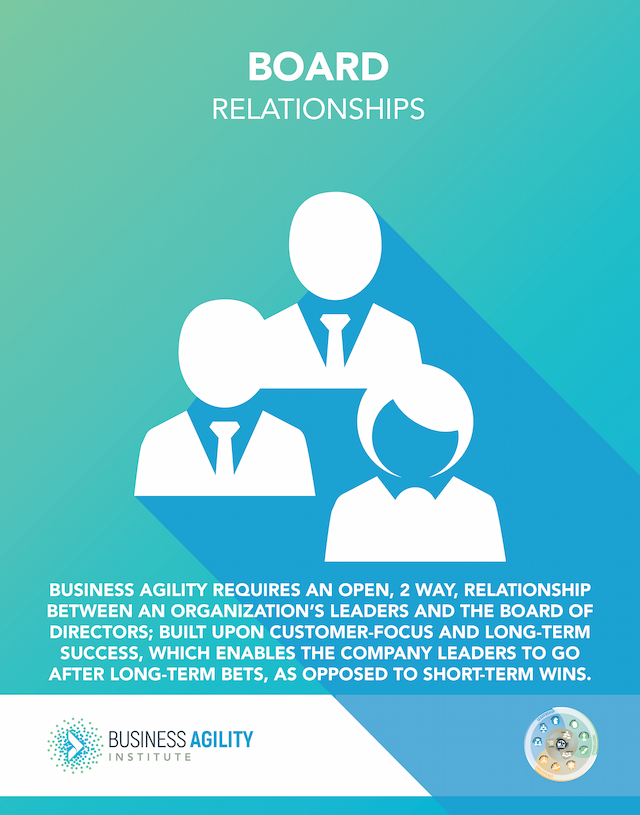Domains of Business Agility
- Customer
- / Customer
- Leadership
- / People Management
- / One Team
- / Strategic Agility
- Individuals
- / Growth Mindset
- / Craft Excellence
- / Ownership & Accountability
- Operations
- / Structural Agility
- / Process Agility
- / Enterprise Agility

Board of Directors
01 Introduction
Business Agility requires an open, 2 way, relationship between an organization’s leaders and the board of directors; built upon customer-focus and long-term success, which enables the company leaders to go after long-term bets, as opposed to short-term wins.
As with the definition of ‘Customer’, Board is a very broad concept. Depending on the organizational structure it could mean; the business owners for a private organization, a shareholder-elected board for a publicly listed corporation, or member-elected board for an association or not-for-profit. Regardless of the structure, the Board has the ultimate fiduciary responsibility for the financial health, continued operation, and regulatory compliance of the organization.
Unlike many of the other domains, an agile board is only subtly different from traditional organizations. As before, the board remains accountable for regulatory compliance and financial health, but this time through the lens of an agile and adaptable organization. Governance & compliance no longer just means annual plans and quarterly reporting. Instead, it means long-term goals with continuous and adaptive planning & reporting. This has significant implications for the business KPIs; moving away from the short-term focus on quarterly earnings reports towards a long-term focus on building customer trust and measuring business results against customer success.
The biggest challenge for boards is in their design and composition as they are the furthest from the customer. Thus, the board must make extra effort to bridge the organizational layers and understand both customer needs and the challenges of the workforce. In doing so, it is important for board members to understand and exhibit an agile mindset; one that prioritizes market adaptability, customer advocacy, and a willingness to experiment. Even the selection committee, when identifying and recruiting new senior executives, needs to prioritize an agile mindset as executive hires can either enhance or jeopardize an agile culture.
In understanding the customer, the board also needs to understand the community and society the customer exists within.The report “ROI of Corporate Responsibility” shows that organizations that invest in strong corporate responsibility initiatives increase their market value between 4-6%, reduce share price volatility between 2-10%, reduce staff turnover by up to 50%, and increase revenue by up to 20%.
Finally, it is important that the Board actively supports any organizational transformation. The latest Business Agility Report showed a 25% improvement between transformations led directly by board vs those led by a manager.
02 Moving from Theory to Practice
Your goal is to promote an agile culture, starting from the board, to remain adaptable in an ambiguous market.
Understand Agile Governance
As the highest level of governance in an organization, the Board of Directors needs to set the standard for adaptive governance. This means holding the organization to account for business outcomes, rather than outputs. It means creating an environment for conducting, and learning from, experiments and market research. It means supporting the CEO when they make a decision for the customer’s benefit but with short-term shareholder impact.
More practically, organizational metrics (KPIs or OKRs) need to measure customer outcomes (traceable to financial benefits) rather than focusing on purely financial metrics. Examples of these measures may be; alignment to customer outcomes (how has our organization positively affected our customer’s corporate scorecard) and failure KPIs (where the CEO and executives are measured by the learning they have acquired from experimentation that hasn't worked).
In addition to their fiduciary responsibilities, the boards must apply greater due diligence to the governance of their organization. This is not due to a lack of trust in their chosen executives, but because an agile organization can, and will, adapt and change rapidly. Because of this, the Board must work closely with the executive to remain informed and make appropriate governance decisions.
Represent the Customer
By their very nature, the board is the part of the organization furthest from the customer. In a business agility transformation, make an effort to bring the board to the customer. That way they understand both the operating mandate of the organization and current market challenges. The board has the duty to challenge executives on their strategic and budgeting practices. Ensuring that the organization remains nimble and can pivot when needed to fulfill changing customer needs.
Ensure Transparency of Information
While remaining aware of regulatory disclosure requirements, the board needs regular access to relevant information from across the organization. Existing board reports are ineffective and often cannot keep up with the changing pace of the business. Tools like an enterprise visibility room are an effective means of improving overall transparency.
03 Measuring your Business Agility Maturity
Crawl
Walk
Run
Fly
Board Focus
The board’s focus is on a combination of short-term results (to please shareholders) and long-term investments (to ensure continued market relevance).
The board has taken the time to truly understand the needs of the customer. Although remain focused on short-term results and long-term benefits.
The board encourages executives to focus on the customer. Yet, they revert to a profit focus whenever there is a short-term dip in the market.
The board encourages executives to focus on the customer in spite of short-term dips that might upset shareholders or the market.
Measure What Matters
We have removed both competing and vanity measures from our organizational KPIs. Our focus is on measures that are “important”; that is, if the measure changes, there is a real impact on our organization.
We measure and incentivize transformational measures (such as cultural change, experimentation, or failure) to encourage our teams to try new things.
We give people measures (e.g. customer satisfaction) the same focus, attention, and incentives as “hard” measures (e.g. revenue and profit).
Our corporate scorecard and annual report clearly demonstrate the quantitative impact (or value) we have brought to our customers which is also representative of how we incentivize our executives.

